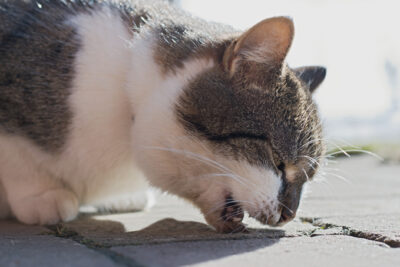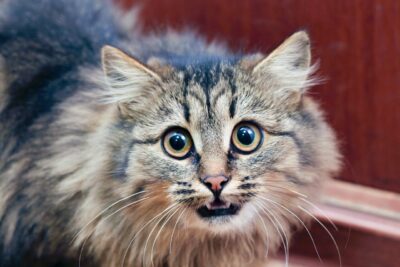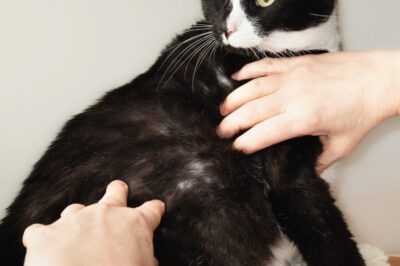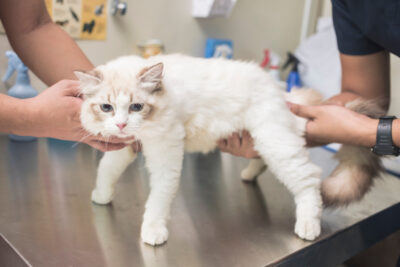14 Cat Stroke Symptoms to Watch For

Strokes, also known as cerebrovascular accidents, occur when something in the body causes a sudden blockage of blood flow to the brain. This sudden blockage also deprives the brain of oxygen. Strokes are rare in cats but are very serious and require immediate veterinary care.
Although the chances of your cat having a stroke are low, it will be helpful for you to know the symptoms of strokes in cats and how to respond in case your cat has one and needs help.
Can Cats Have Strokes?

Yes, cats can have strokes, but it’s unlikely. Strokes in cats are classified according to how the stroke occurred:
Ischemic stroke. A blood clot either forms in one of the brain’s blood vessels (thrombus) or travels from another part of the body to the blood vessel in the brain (embolus).
Hemorrhagic. One of the brain’s blood vessels bursts. Leakage from the damaged vessel increases pressure within the brain and damages brain tissue.
Within these two broad classifications, many underlying health conditions, including those listed below, can cause a cat’s stroke. However, in most cases of cat strokes, the cause is unknown.
- Diabetes
- Heart disease
- Kidney disease
- Hyperthyroidism
- Migrating parasites (e.g., heartworms)
- High blood pressure
- Cancer that has spread to the brain
Any breed of cat can have a stroke. Strokes usually occur in adult cats around 9 years of age (1), but they can occur at any age.
Symptoms of a Stroke in a Cat

Cat stroke symptoms appear suddenly and are at their worst within the first 24 hours after the stroke occurs. Several factors determine the severity of stroke symptoms in cats, including:
- Area of brain tissue damage
- Extent of brain tissue damage
- How long the brain has been deprived of blood and oxygen
Here’s a list of common symptoms of strokes in cats:
- Blindness
- Unequal pupil sizes
- Rapidly moving pupils
- Muscle spasms
- Weakness
- Head tilt
- Seizures
- Circling
- Arched body
- Stumbling
- Disorientation
- Sudden collapse
- Abrupt behavioral changes
- Head pressing against a wall
The stroke symptoms related to the eyes (unequal pupil sizes, rapid pupil movement, blindness) occur because the nerves that control eye movement and vision originate in the brain. The eyes will be affected if brain damage from a stroke occurs near these nerves.
The brain plays an essential role in muscle movement and coordination. A stroke will affect your cat’s ability to walk and move about normally. If your cat is having a stroke, you will likely see symptoms like stumbling, circling, and muscle spasms.
The brain also plays a key role in a cat’s behavior. Brain damage from a stroke could cause abrupt changes in behavior. For example, a cat who is usually docile and laid back may suddenly become aggressive and act out of character. You may also see unusual behavior like head pressing.
Be aware that many of these symptoms also occur with other neurologic conditions in cats, like vestibular disease, which affects a cat’s balance and coordination.
What to Do If You Suspect Your Cat is Having a Stroke

If you think that your cat is having a stroke, act quickly. Take your cat to your veterinarian immediately for diagnosis and treatment. Strokes can cause permanent brain damage and possibly be fatal, so don’t hesitate to take your cat to the vet or go straight to the emergency veterinarian.
Because the symptoms of strokes in cats resemble those of other neurologic conditions, your vet will need to rule out these other diseases. First, your vet will perform a physical exam and ask questions about your cat. Provide your vet with as many details as possible, such as those listed below:
- Signs that you noticed
- When the signs started
- Current medical conditions
- Any history of neurologic issues, including previous strokes
Your vet will then do diagnostic testing to confirm that your cat is having a stroke. This diagnostic work-up includes basic lab work, such as bloodwork and urinalysis. This lab work can help identify underlying diseases, such as kidney disease or diabetes, that could contribute to a stroke.
Analysis of cerebrospinal fluid, which is the fluid in the brain and spinal cord, can also help diagnose strokes. A blood test called a D-dimer test can help identify abnormal blood clots that may have caused the stroke.
Advanced diagnostic testing, such as CT (computed tomography) and MRI (magnetic resonance imaging), can detect brain abnormalities. Your vet would likely need to refer you to another facility for advanced imaging.
The earlier that treatment starts (ideally within the first 24 hours of the stroke), the better the chances of survival and recovery. Treatment is supportive and requires hospitalization. Here is a list of treatments for cats having a stroke:
- Oxygen supplementation
- Intravenous fluid therapy
- Seizure medications, if necessary
- Feeding/adequate nutrition
- Treating underlying conditions
- Assistance with peeing and pooping
- Physical therapy
- General comfort
Cat Stroke Prognosis

With early treatment, most cats having a stroke will recover and regain most of their motor skills. Also, cats with relatively mild symptoms and good overall health tend to recover well after a stroke.
However, successful treatment is not guaranteed, especially if the underlying cause cannot be identified and treated. Delayed treatment can also make a good recovery less likely because of the potential for significant and possibly permanent brain damage. In these cases, cats who survive will likely have permanent motor deficits.
Your vet will be able to determine your cat’s prognosis after examining and diagnosing your cat and observing how they respond to treatment. If your vet was able to pinpoint the underlying cause of your cat’s stroke, your cat may need lifelong therapy to manage that condition and prevent another stroke.
Quality of life is reasonably good for cats who recover well from a stroke, but life could be more difficult for cats whose symptoms were severe and who permanently lost some of their motor skills.
Reference
- Altay, Ulrike Michal et al. “Feline cerebrovascular disease: clinical and histopathologic findings in 16 cats.” Journal of the American Animal Hospital Association vol. 47,2 (2011): 89-97. doi:10.5326/JAAHA-MS-5480









